On the fourth day of Navaratri, devotees across Nepal are performing the ritual worship of Kushmanda Devi at their homes or temples. According to Hindu traditions, Kushmanda Devi, one of the nine forms of Goddess Durga, is honored on the Chaturthi (fourth day) of the lunar calendar during the Ashwin Shukla Paksha.
Kushmanda Devi is revered for her power to alleviate the three types of suffering: physical (Adhibhoutik), mental (Adhyatmik), and divine (Adhidaivik). The term “Kushma” refers to these three sufferings, and it is believed that devotees who seek her refuge are freed from these hardships. Ancient texts describe her holding a pot of alcohol and a vessel filled with blood, symbolizing her control over the cosmic energy.
In the Durga Saptashati, a sacred text, it is said, “Kutsitah Ooshma Kushma–Trividhatapayutah Samsarah, Sa Ande Maansapeshyamudararupayam Yasyah Sa Kushmanda.” This verse highlights how the universe, filled with the threefold miseries, resides in her cosmic womb, symbolizing her universal role as Kushmanda.
Navaratri began on Ashwin 17 (October 3) with the traditional ritual of Ghatasthapana, during which barley seeds were planted as a symbolic gesture of renewal. On the first day, devotees worshiped Goddess Shailaputri, the first form of Durga, followed by Brahmacharini on the second day and Chandraghanta on the third day. Each form of Durga is worshiped in sequence during the nine-day festival.
Today, on the fourth day, Kushmanda Devi is being worshiped with full devotion. During Navaratri, devotees recite the Durga Saptashati and other scriptures like the Shreemad Devi Bhagavatam, performing daily rituals to seek blessings for power, prosperity, and wisdom. It is widely believed that offering prayers to the goddess during Navaratri brings spiritual strength and divine grace.
The festival of Dashain, also known as Durga Paksha, involves the worship of nine forms of Goddess Durga, known as Navadurga. The worship sequence begins with Shailaputri, Brahmacharini, Chandraghanta, Kushmanda, Skandamata, Katyayani, Kalaratri, Mahagauri, and Siddhidatri on the ninth day. This period is considered highly auspicious for Hindus across Nepal.
As the festival progresses, large crowds of devotees are visiting Shakti Peeths (sacred power spots) across the country. In Kathmandu Valley, temples such as Guhyeshwari, Jayabageshwari, Maitidevi, Kalikasthan, Naxal Bhagawati, Bhadra Kali, Shobha Bhagawati, Rakta Kali, Sweta Kali, Bijeshwari, and others are filled with worshippers from early morning.
Similarly, outside the valley, significant temples like Palanchok Bhagawati, Nala Bhagawati, Chandeshwori, Palchok Bhagawati, Kamalamai, Ichhakamana, Manakamana, Gadhimai, Chhinnamasta, Gahwamai, Baglung Kalika, Bindhyabasini, Talbarahi, Shaileshwari, Ugratara, and Bageshwari are witnessing a massive influx of devotees.
The Navaratri festival, celebrated for nine days, culminates with Vijaya Dashami and extends until Kojagrat Purnima, marking 15 days of celebrations for the grand Dashain festival in Nepal.
Source: RSS






